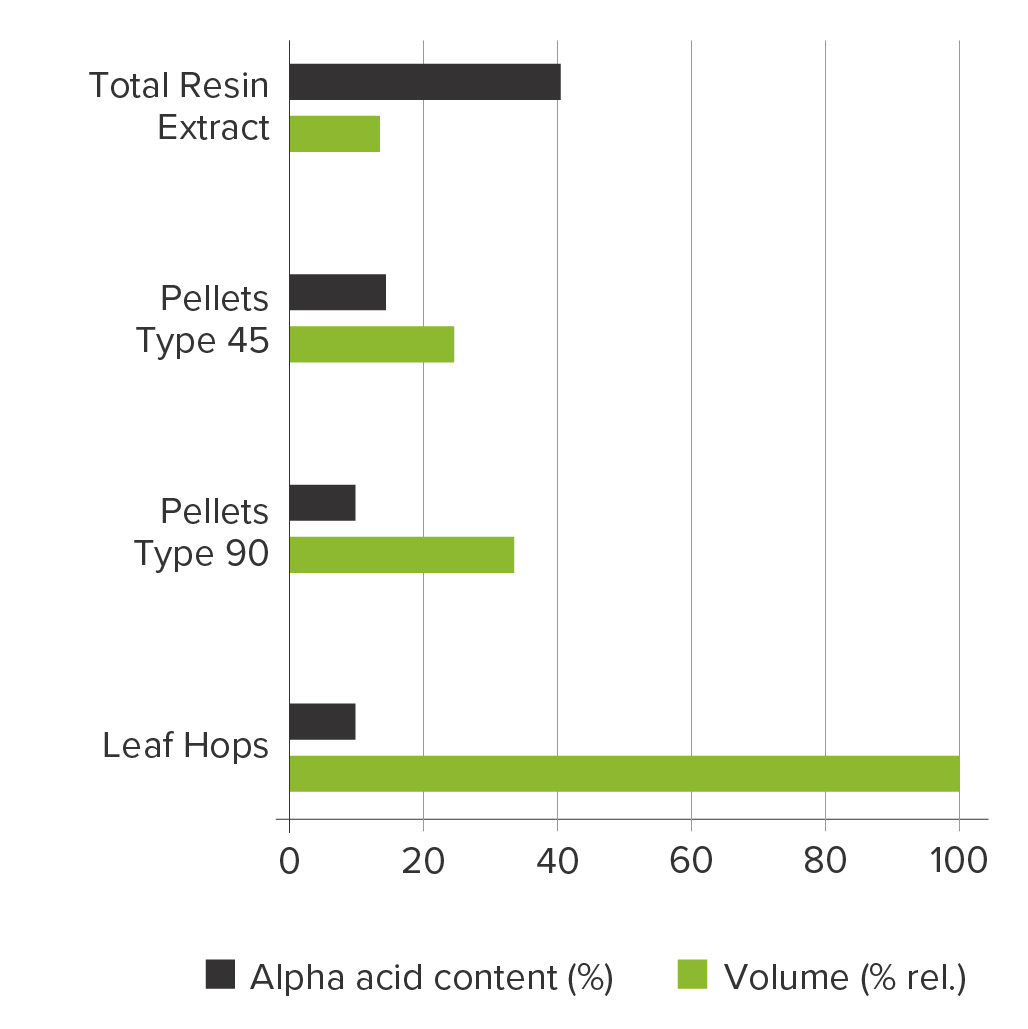
Total Resin Extract
Overview
Total Resin Extract (TRE) is produced from aroma or bitter hop varieties through extraction with pure alcohol derived from fermentation. TRE contains all of the hop bitter acids (hard and soft resins) and hop oil components of the original leaf hops.
TRE is added to the kettle and can be used to partially or entirely replace leaf hops, hop pellets or CO2 hop extract.
TRE offers a concentrated and practical alternative to leaf hops or hop pellets with an identical bitterness. Moreover, TRE has a long shelf life.

Specifications
- Short description
- hop extract for bittering during wort boiling
- Alpha acids
- 20 - 55 %
- Iso-alpha acids
- 0.5 - 2.0 %
- Beta acids
- 15 - 30 %
- Hop oils
- 3 - 12 %
- Residual ethanol
- < 0.3 %
- pH
- 6.2 ± 0.5
- Density
- ca. 1.0 g/ml (20 °C / 68 °F)
- Viscosity
- 400 - 1000 mPas (45 °C / 113 °F)
Properties
Appearance
Dark green in color, TRE is a thick syrup/paste.
Flavor
The flavor and especially the bitter characteristics of the original hops are completely retained. Early additions of TRE during wort boiling mainly serve to impart bitterness.
Utilization
If TRE is boiled for at least 50 minutes, utilization within the range of 30 - 40 % can be expected. Actual utilization will vary from brewery to brewery due to differences in equipment and process conditions.
Quality
All Hopsteiner® products are processed in facilities which fulfill internationally recognized quality standards.
Packaging
Our products are delivered in their respective recommended standard packaging. Alternatives may be possible upon customer request.
Standard packages of our processing plants in the USA (US) and Germany (DE) are:
- Cans 0.5 - 3.1 kg (DE)
- Drum 200 kg (US / DE)
The extract can be adjusted to a specific bitter content by admixing tannin extract or glucose syrup.
Usage
TRE is typically added to the wort kettle as a complete or partial replacement for leaf hops or hop pellets.
Dosage
Kettle additions of TRE are based on the concentration of bitter substances (CBV), an estimated or known utilization and the desired intensity of bitterness in the beer.
Application
Pre-warming cans of TRE is not necessary. Suspending punctured cans in the boiling wort will ensure that all of the extract is completely flushed out into the kettle.
If TRE is added by means of automatic dosing units, it should be warmed to 45 °C (113 °F) and gently mixed to ensure perfect dosing.
Storage
The recommended storage temperature in the original unopened packaging is < 10 °C (50 °F).
Short-term, transport-related temperature deviations do not affect product quality.
Best Before Date
Under the recommended storage conditions, the shelf life from the date of production/ packaging is at least 8 years.
Safety
Ensure good ventilation of the workplace and wear personal protective equipment. Avoid contact with eyes and skin. Do not inhale vapors or dusts. For full safety information, please refer to the relevant Hopsteiner® safety data sheet.
Analytical Methods
International approved methods listed in commitees such as ASBC or Analytica-EBC using current standards are applied.
Product analytics
- Analytica EBC 7.6 (LCV)
- ASBC Hops-8 (II) (LCV)
- Analytica-EBC 7.8 (HPLC)
- ASBC Hops-16 (HPLC)
The product is normally dosed according to its Conductometric Bitter Value (CBV) as this value better represents its bitterness potential.
Note: CBV = LCV (EBC 7.6) + 50 % of iso-alpha acids (EBC 7.8)
- Analytica-EBC 7.10 (Distillation)
- ASBC Hops-13 (Distillation)
Technical Support
We are pleased to offer assistance and advice on:
- safety data sheets
- support for brewing trials on a pilot or commercial scale
- analytical services and information about analytical procedures
Disclaimer: The information provided in this document is believed to be correct and valid. However, Hopsteiner® does not guarantee that the information provided here is complete or accurate and thus assumes no liability for any consequences resulting from its application.
Last updated: 27/11/2023
Save PDF